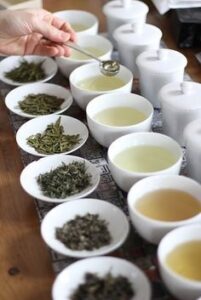
While many may recognize green tea, some may be surprised to discover Hojicha, a roasted green tea that appears brown rather than green. Among green teas, various shades and flavors exist, reflecting their unique characteristics. The primary distinction between green tea and other tea varieties, such as black tea and oolong tea, lies in the steaming process applied to the leaves. This method not only eliminates the grassy aroma but also halts oxidation, preserving the vibrant green color.
Green tea can be categorized into four main types:
1. Gyokuro
Gyokuro is a premium variety of green tea characterized by its dark green, twisted leaves. These leaves are shaded from sunlight before harvest, allowing them to develop a mild, slightly sweet flavor. The shading enhances the theanine content, promoting relaxation while reducing the catechins that contribute to bitterness. The resulting tea boasts a fragrant aroma, bright green hue, and a delicate taste, making it a high-grade tea typically produced in limited quantities, leading to a higher price point. Gyokuro is often reserved for ceremonial occasions.
2. Matcha
Matcha is perhaps the most well-known type of green tea, derived from Tencha, which consists of shade-grown tea leaves that are meticulously ground into a fine powder using traditional stone mills. This tea is favored in tea ceremonies due to its smooth flavor and versatility. Matcha is available in various grades, suitable for different uses, including culinary applications and ceremonial preparations. The quality of matcha can be assessed by its color; darker matcha typically indicates superior quality and a higher nutrient content.
3. Sencha
Sencha is the most widely consumed green tea in Japan, accounting for over 60% of the country’s green tea production. Unlike Gyokuro, Sencha does not require shading during cultivation and is harvested during the first or second flush of the year. Following harvest, the leaves undergo steaming, kneading, and drying processes, resulting in a fragrant tea with a slightly astringent flavor.
4. Bancha
Bancha is considered a lower-grade green tea, harvested later in the season (third or fourth flush). It consists of older leaves and stems collected when tea trees are not producing new shoots. Bancha is generally milder in taste, with a yellowish-green color and a less pronounced aroma compared to other green teas. This affordable option is often enjoyed as a daily drink.
The enjoyment of each type of green tea ultimately depends on individual taste preferences, preparation methods, and food pairings. Regardless of the variety, all green teas offer beneficial nutrients, though the amounts may vary based on the specific type.


